|
Medieval Austria
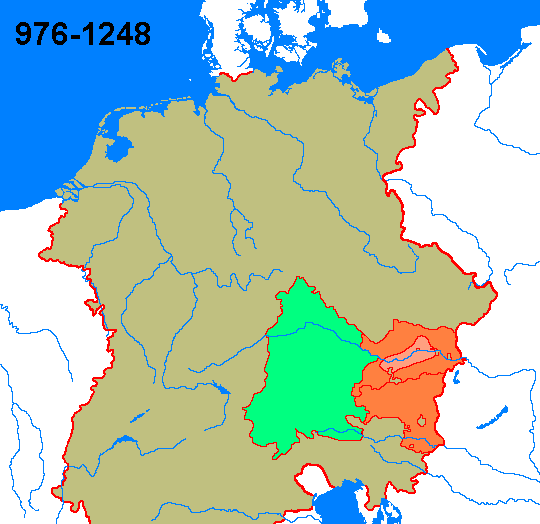
 = "Ostarrîchi” ca 1000
= "Ostarrîchi” ca 1000
 = Territorial gains to 1192
= Territorial gains to 1192
 = Temporary acquisition 1139-56
= Temporary acquisition 1139-56
 = Other parts of the Holy Roman Empire
= Other parts of the Holy Roman Empire
When the future Holy Roman Emperor Otto the Great defeated
the Hungarians in the battle of Lechfeld AD 955 were the lands that comprise
modern Austria reconquered. Along the river Danube was a margraviate created in
an effort to organise the defence against Hungary. This margraviate was a part
of the duchy of Bavaria and was according to a document from AD 996 called
”Ostarrîchi” by the local population. The document is the oldest evidence of a
territory called ”Austria”, but the etymology to the name is uncertain. It
probably means ”Eastern realm” and could have originally been used for all of
Germany (which was the eastern half of the Frankish Empire) and later evolved
to just refer to the small margraviate next to the eastern border.
From AD 976 was Austria ruled by the house of Babenberg
who benefited from the country's strategic location. The Danube was an
important trade route which connected Germany with South Eastern Europe
(principally the Byzantine Empire) and generated much revenue from customs
duties. The Babenberg margraves extended Austria's borders greatly and became
dukes of Bavaria 1139 when its duke had fallen out of the emperors favour.
The Bavarian duchy was however returned to its previous occupants 1156 when
they came to terms with the emperor. The house of Babenberg was compensated
for this loss by the emperor by elevating Austria to a duchy and freeing it
from the previous subordination of Bavaria. The neighbouring margraviate of
Styria was 1180 also freed from Bavarian overlordship and elevated to a duchy.
Through inheritance was Styria thereafter united with Babenberg Austria 1192.
A notable event occurred the same year when the English king Richard Lionheart
was captured on his way home from the Holy land by the Babenberg duke Leopold V
The duke demanded and got a ransom of 150 000 mark (2-3 times England's annual
revenue) to release the crusader king.
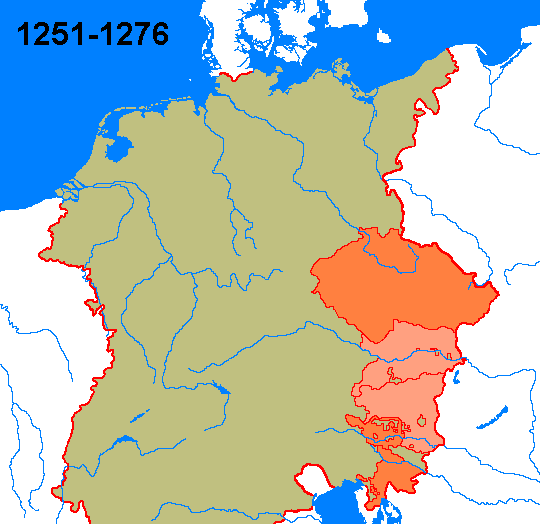
 = Austria and Styria
= Austria and Styria
 = Territorial gains to 1269
= Territorial gains to 1269
The house of Babenberg became extinct 1248 and after a
short interlude by Hermann of Zähringen was Přemysl Otakar elected to
duke of Austria 1151. He was also margrave of Moravia and inherited the Bohemian
crown 1153 as Ottokar II. Not satisfied with this, Ottokar II also made several
attempts to be elected as king of Germany. In a struggle against Hungary managed
Ottokar to reunite Styria with Austria 1261, which was followed up by the
acquisitions of Carinthia and Carniola in 1269. He also led two campaigns against
the heathen Prussians and got the town Königsberg named after him (German for
"King's mountain", renamed to Kaliningrad in 1946).
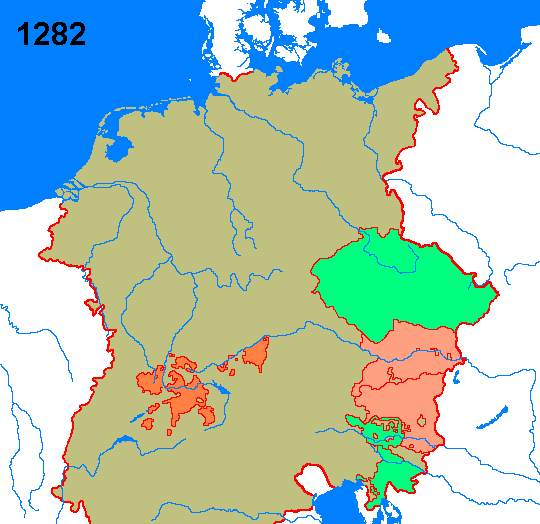
 = Austria and Styria
= Austria and Styria
 = Habsburg possessions
= Habsburg possessions
 = Lost territories 1276
= Lost territories 1276
After another failed attempt to be elected King of Germany 1273, choose
Ottokar II to refuse to recognise the victor Rudolf of Habsburg, and thus
sowed the seed to his own demise. When Ottokar tried to undermine Rudolf's
authority in the Holy Roman Empire, the king replied with the decree that all
imperial fiefs that had changed hands since the death of the last generally
recognised German king in 1250 should be returned to the crown. This was a
mortal blow against Ottokar II's regional empire and he was 1276 forced to
cede all his fiefs except Bohemia-Moravia. Ottokar II tried to reconquer these
fiefs in 1278 but was killed in the battle on the Marchfeld.
Rudolf granted
Carinthia and Carniola to the Meinhardinian dynasty who ruled Tyrol. But
Austria and Styria was 1282 granted to Rudolf's owns sons Albrecht and Rudolf
II, whereupon these lands were united with the house of Habsburg's other
possessions in Swabia (present south-eastern corner of Germany and northern Switzerland).
This marked the beginning of the long Habsburg era in Austrian history,
which would last until 1918.
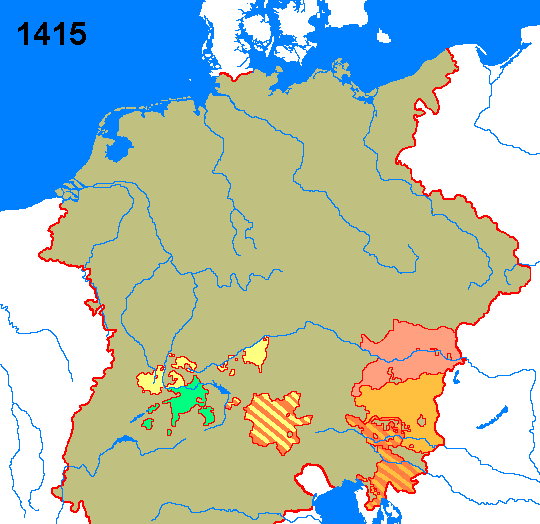
 = Territorial losses to 1415
= Territorial losses to 1415
 = Territorial gains 1335-1382
= Territorial gains 1335-1382
 = Possessions of the Albertine line (1379-)
= Possessions of the Albertine line (1379-)
 = Possessions of the Tyrolean line (1411-)
= Possessions of the Tyrolean line (1411-)
 = Possessions of the Styrian line (1411-)
= Possessions of the Styrian line (1411-)
The house of Habsburg was one of Germany's most prominent dynasties and
three of its members were German kings 1273-1291, 1298-1308 and 1314-1330.
But thereafter would it not be another Habsburg king until 1438 when they
regained the German throne (and kept it without interruptions until 1740).
In the meantime was the Habsburgs occupied with the expansion of their
hereditary lands. Carinthia and Carniola became Habsburg lands when the
Meinhardinian dynasty became extinct. Rudolf IV succeeded to seize control
of Tyrol 1363 thanks to the Habsburg widow of the former Tyrolean count who
did not want her husband's brother (a Bavarian duke) to inherit the county.
The same Rudolf made several forged documents in an effort to enhance
the Habsburg dynasty's standings in Germany. Among other things was a
fake document declaring Austria an archduchy. Every Habsburg ruler has since
then used the unique title archduke although it did not get official approval
until 1453.
However, a series of partitions of the Habsburg lands between different
branches of the dynasty would weaken Austria. The Habsburg possessions were
1379 divided in the fashion that Albrecht III (the Albertine line) inherited
Austria while his brother Leopold II (the Leopoldine line) got the rest. The
Leopoldine line was thereafter split in a Tyrolean line and Styrian line 1411.
The Leopoldine line (and then the Tyrolean line) inherited the house of Habsburg's
original possessions in Swabia. A new state, which would be known as Switzerland,
had however been created close to the Habsburg domains in 1291. The peasants
in this area rejected Habsburg rule and joined Switzerland, which would defeat
the Habsburg armies at Morgarten 1315 and Sembach 1386. After the last battle,
most Habsburg possessions in Swabia were lost one by one to the Swiss until 1415
when Aargau (home to the Habsburg castle from which the dynasty got its
name) joined Switzerland. These losses were partly compensated by the
acquisitions of Feldkirch, Bludenz, Hohenberg and parts of present Vorarlberg
(1381) along with Trieste (1382).
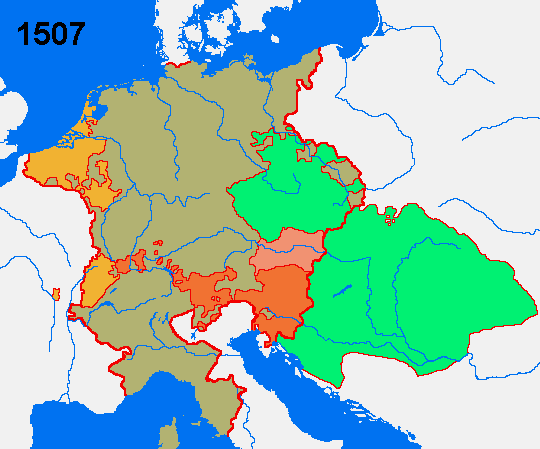
 = Austria
= Austria
 = The Burgundian lands (from 1482)
= The Burgundian lands (from 1482)
 = Territorial gains 1457-1507
= Territorial gains 1457-1507
 = Temporary acquisitions 1437-1457
= Temporary acquisitions 1437-1457
The Albertine duke Albrecht V (II) was 1437 elected king of Bohemia and
also gained the Hungarian and German crowns the following year (all this as
successor to the extinct house of Luxemburg. Albrecht II died however 1439
and his posthumous son who inherited the crowns of Bohemia and Hungary died
already in 1457 as the last member of the house of Habsburg's Albertine line
Bohemia and Hungary was lost for the Habsburg dynasty, but Austria was
inherited by Friedrich III from the Styrian line who had been elected German
king already in 1440. Friedrich III was succeeded 1493 by his son Maximilian
who three years earlier had taken over Tyrolean line's possessions. All Habsburg
lands were now reunited under one Habsburg ruler. Through marriage had
Maximilian secured the rich Burgundian lands for the Habsburg dynasty and
they were inherited by his son Philip the Fair in 1482. The original Habsburg
controlled lands were now called the Austrian hereditary lands and they were
expanded with the county of Gorizia in 1500 and some Bavarian districts in 1507.
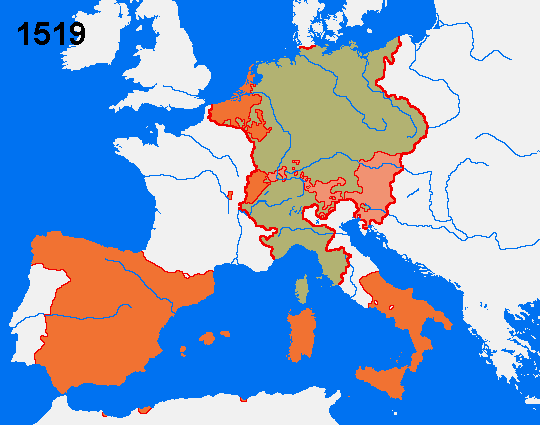
 = The Spanish crown and the Burgundian lands
= The Spanish crown and the Burgundian lands
 = The Austrian lands
= The Austrian lands
The expansion of the House of Habsburg was however not over. Maximilian
managed to marry his son Philip the Fair with the Spanish princess Joanna,
which would lead to the inheritance of the Spanish crown by his grandson
Charles V in 1516. Charles V would then succeed his grandfather as Holy
Roman Emperor and ruler of the Austrian lands in 1519. As a result of a
series of well planned marriages had thus Charles V's branch of the Habsburg
dynasty in just half a century advanced from being rulers of a small
corner of Germany to rule over a vast Empire "where the sun never set".
The history of Austria continues on this page. |

